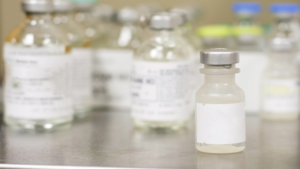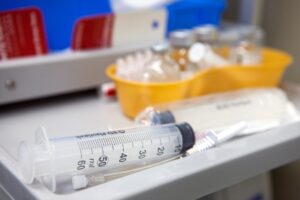Editor’s note: This story was first published by STAT on October 8, 2021.
Much of the current drug-pricing agenda proposed by President Biden and by Congress is based on the belief that greater government control — rather than free market competition — is the best way to lower drug prices. This view that competition is not working is particularly true for U.S. biosimilars, which enter the market after patents on a biologic drug expire.
A notion in the policy community is that competition between biologics and their biosimilars does not save patients and taxpayers as much as well-functioning generic competition for regular pharmacy-based small-molecule drugs. But we argue that the evidence shows the opposite: Biosimilar competition produces greater savings per drug than generic competition.
We argue that this leads some well-intended proposals to have the government intervene and “incentivize” biosimilar uptake that will perversely result in less price competition, not more.
Biologic drugs are complex molecules made by living cells. They are typically injected by doctors in their offices and are more expensive than traditional drugs sold in pharmacies, reflecting their higher manufacturing, research, and development costs. A 2019 industry report shows that biologics made up about 2% of the volume of prescriptions but 43% of overall drug spending.
Sign up for Schaeffer Center news
In an effort to spur development of biologic competition after patents expire, Congress passed the Biologics Price Competition and Innovation Act of 2009. Since then, some have argued that biosimilar competition does not work as well as for small molecule generics for pharmacy-based drugs that often come in pill form. The evidence lays out a sharply different picture.
This negative view of biosimilar competition is partly due to one of the first high-profile launches, Pfizer’s Inflectra in 2016, which was designed to compete against Janssen’s Remicade in treating rheumatoid arthritis and other diseases. At launch, Inflectra’s price was only about 10% lower than Remicade’s. By contrast, generic drugs are typically 80% to 85% cheaper, though such a reduction generally occurs only after several generics have entered the market. Eventually, however, price competition worked and in four years, the price of Inflectra was slashed in half, and its entry drove Remicade prices down 50% as well, according to government data.
Other systematic evidence shows biosimilar competition cutting prices only by about 30%. This helped motivate the recent Advancing Education on Biosimilars Act, which became law in April 2021. It aims to increase prescribing of biosimilars and lower their prices by having the government educate patients and providers about the value of biosimilars.
The policy community’s view that the savings generated by biosimilar competition pales in comparison to saving from generics is in stark contrast to the impact on what patients pay. This is because small price cuts for expensive drugs matter more than large cuts for cheap ones.
We analyzed the 21 biosimilars that have entered the U.S. market to date among the 29 approved so far by the FDA. Using data from GoodRx , we found that before market exclusivity expired, the average price of brand name biologics now targeted by biosimilars was $2,216 compared to an average of $101 for brand-name small molecule drugs.
The biosimilars that have entered the market are on average 30% cheaper than their biologic competitors — representing a savings of about $665 off the average price. That compares much more favorably to an 85% price cut from generic competition, which yields about $86 in savings.
If biologics cost about two-and-a-half times the price of small-molecule drugs, the absolute price reductions in dollars would be similar. But biologics have generally been about 22 times as expensive. In other words, biosimilar competition is saving patients more money than generic competition. This is supported by a recent study showing that biologics that are now targeted by biosimilars were on track to cut prices by 56% from launch.
Overall savings for patients are determined not only by price differences but also by volume. Lower prices matter more for drugs that are taken often. Biosimilars grab about 50% of the previous volume from the expiring brand, and that share increases over time. The corresponding share is 88% for generics. Despite this, we found that the aggregate savings enabled by biosimilars was 4.3 times higher than that of generics. Thus, overall savings, and not only savings per prescription, is larger from biosimilar competition than generic competition.
The policy proposals that emerge through the lens of biosimilars not generating as much savings as generics therefore tend to be highly misguided. Some have suggested that biologics should be regulated like utilities, with 10% profit restrictions even though many economists have stressed the adverse consequences of price controls for regulated utilities. These proposals — and the data offered to support them — miss the most basic economics of how the industry works, with earnings from marketed drugs paying for the losses of the 86% of drugs that never make it out of the FDA trial process.
What would really harm competition in this space are proposals such as those requiring brands and biosimilars to be reimbursed the same amount to prescribers (also called shared reimbursement codes), as proposed by the main Medicare advisory committee, which would surely discourage future price competition. Being reimbursed at the same price would not generate enough incentive to bring biosimilars to market, thereby resulting in less market entry. By being reimbursed at the same rate as the originator, biosimilar manufacturers would have difficulty recouping the R&D costs needed to enter, which are much higher than those for generics.
The new biosimilars market will likely continue to grow with more competition, just as generic competition grew slowly after the 1984 Hatch-Waxman Act that stimulated it. By one estimate, biosimilars could save the U.S. up to $100 billion over the next five years and recent evidence is emerging that market shares and price reductions of biosimilars are increasing over time.
Resisting the urge to have the government intervene and let competition in this new market continue to evolve is the most useful approach to generating even more savings for patients.



